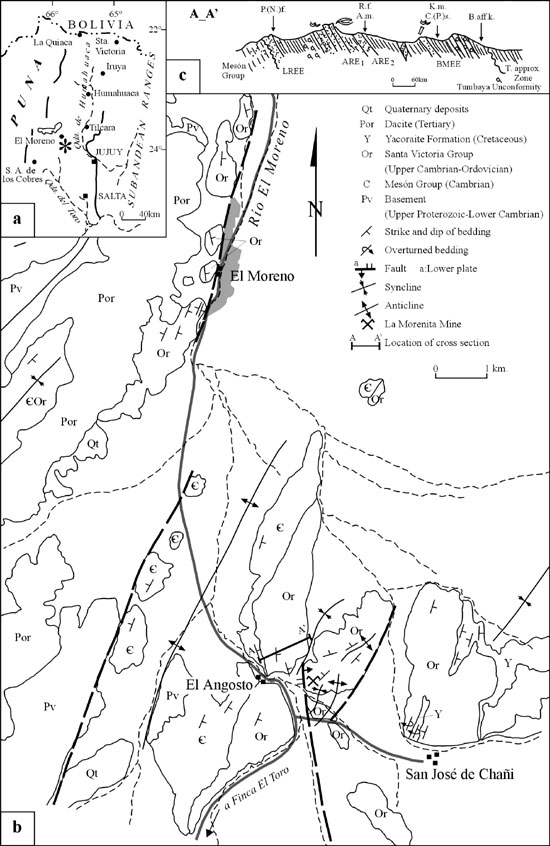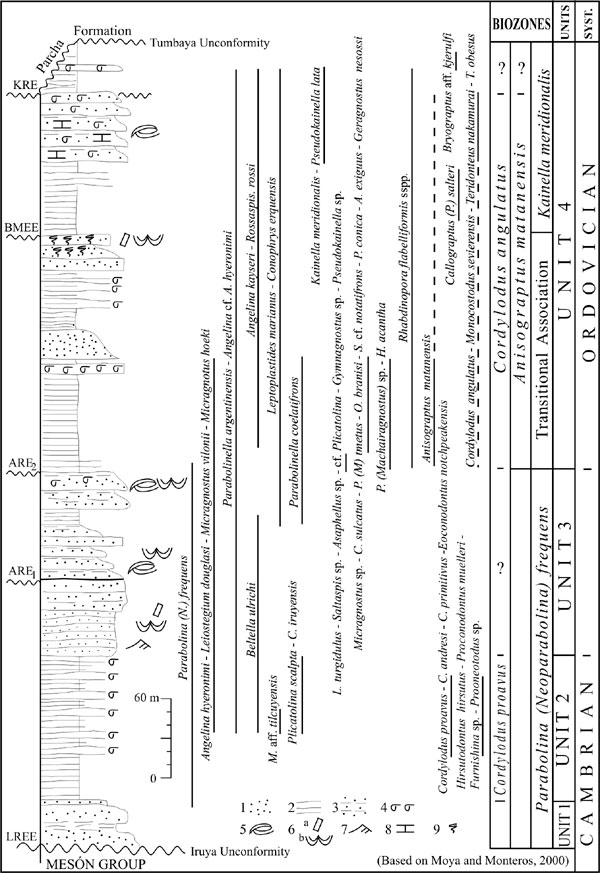
Late Cambrian – Tremadocian faunas and events from Angosto del Moreno Section, Eastern Cordillera, Argentina
M. Cristina Moya1, Susana Malanca2, Julio A. Monteros2, Guillermo L. Albanesi3, Gladys Ortega3 and Luis A. Buatois4
1 CONICET – CIUNSA. Universidad Nacional de Salta. Buenos Aires 177, 4400 Salta. E–mail: crismoya@unsa.edu.ar
2 CIUNSA. Universidad Nacional de Salta. Buenos Aires 177, 4400 Salta. E–mail: smalanca@unsa.edu.ar / julpaleo@unsa.edu.ar
3 CONICET. Museo de Paleontología, Universidad Nacional de Córdoba, C.C. 1598, 5000 Córdoba. E–mail: galbanesi@arnet.com.ar, gcortega@arnet.com.ar
4 CONICET – INSUGEO. Casilla de Correo 1, 4000 San Miguel de Tucumán, Argentina. E–mail: ichnolog@infovia.com.ar
Key words: Faunas. Events. Late Cambrian – Tremadocian. Eastern Cordillera. Argentina.
Introduction
The Santa Victoria Group (SVG, late Upper Cambrian – Caradocian) comprises pre–Ashgillian Ordovician deposits of the Argentinean Eastern Cordillera. The most significant section of the SVG in the western flank of the Eastern Cordillera is located in the Angosto del Moreno area (Figure 1a, b). At this locality, the SVG unconformably overlies the Mesón Group (Cambrian s.l.), and unconformably underlies Cretaceous rocks (Yacoraite Formation). Upper Cambrian to lower Lower Ordovician units are separated from upper Lower to Middle Ordovician units (Parcha and Sepulturas formations) by the Tumbaya unconformity (Figure 2). The Angosto del Moreno Section of the SVG is exceptional in terms of the quality of exposures, continuity of deposits, richness of fossils, and accessibility. Diverse aspects concerning the Ordovician geology of this study area have been discussed by Moya et al. (1994, 1998), Moya and Albanesi (2000), Moya and Monteros (2000), Malanca and Brandán (2000), and Gómez Martínez et al. (2002). Previous data and recent paleontological collections enable a preliminary biostratigraphic scheme (Figure 2) for the Upper Cambrian to Tremadocian units of the SVG. A synthesis of the sequence stratigraphy and depositional environments of these units is given by Buatois et al. (this volume).
Late Cambrian – Tremadocian faunas and tectono–eustatic events
Five well–differentiated faunal associations were recognized in Upper Cambrian – Tremadocian deposits of the Angosto del Moreno. These associations define five stratigraphic intervals, which correspond to transgressive–regressive cycles bounded by sequence stratigraphic boundaries. These events and stratigraphic intervals are also documented in other areas of the Eastern Cordillera (Moya et al., this volume). We consider that the events identified can be correlated quite accurately with tectono–eustatic fluctuations recorded worldwide for the Late Cambrian – Tremadocian: Lange Ranch Eustatic Event (LREE; Miller, 1984), Acerocare Regressive Event (ARE; Erdtmann, 1986) including two episodes (ARE1–ARE2, Cooper and Nowlan, 1999), and Black Mountain Eustatic Event (BMEE; Miller, 1984). A regional regressive event succeeding the BMEE is recognized in the Argentine Eastern Cordillera. This event, the Kainella Regressive Event (KRE; Moya et al., this volume), would correspond, though still not verified, with the Peltocare Regressive Event (PRE; Erdtmann, 1986).

Figure 1. A. Location map. B. Geologic map of Angosto del Moreno area. C. Profile of the Upper Cambrian –Tremadocian deposits.
First Interval (LREE–ARE1). This interval embraces units 1 and 2 of Buatois et al. (this volume), and the lower interval of unit 3. The lowermost fossil records of the Angosto del Moreno Section, which correspond to Parabolina (Neoparabolina) frequens (Barrande), occur in the upper part of unit 1. The trilobite fauna from these strata is monospecific and it also occurs in shales of the lower third of unit 2, in coincidence with a maximum flooding event. The shelly fauna increases notably within the highstand systems tract in middle and upper terms of the unit. Sandstone and coquina beds that characterize this part of the sequence contain P (N.) frequens together with Parabolinella argentinensis Kobayashi, Angelina hyeronimi (Kayser), Angelina cf. A. hyeronimi, Leiostegium douglasi Harrington, Beltella ulrichi (Kayser), Plicatolina scalpta Harrington and Leanza, Micragnostus vilonii Harrington and Leanza, Micragnostus hoeki Kobayashi, Micragnostus aff. M. tilcuyensis (Kayser) and Ciceragnostus iruyensis (Kayser), some of which range up to unit 4. One of the younger coquinas yielded conodonts of the Hirsutodontus hirsutus Subzone (Cordylodus proavus Zone), indicating a late Cambrian age. The subzone is represented by Cordylodus proavus Müller, Cordylodus cf. proavus, Cordylodus primitivus Bagnoli et al., Cordylodus andresi Viira et al., Eoconodontus notchpeakensis (Miller), Hirsutodontus hirsutus Miller, Proconodontus muelleri Miller, Furnishina sp., and Prooneotodus sp. This interval is capped by a shallowing–upwards sandstone succession (lower part of unit 3). Only trace fossils were found in this interval.
Second Interval (ARE1–ARE2). This interval comprises the middle and upper parts of unit 3. It is characterized by storm–dominated upper offshore to upper shoreface deposits. A sequence boundary, regarded as co–planar surface or amalgamated flooding surface/sequence boundary, is present at the base of this second interval (Buatois et al., this volume). The transgressive systems tract is characterized by a fining–upward succession containing abundant trace fossils, which culminates in maximum flooding upper offshore deposits with complete specimens of P. (N.) frequens. This species is associated with Parabolinella coelatifrons Harrington and Leanza and the first records of shumardiids and pelturids, as well as, Conophrys erquensis (Kobayashi) and Leptoplastides marianus (Hoek). Nevertheless, Jujuyaspis keideli Kobayashi was not recorded, as it occurs in other areas of the basin (Moya et al., this volume). The highstand systems tract is represented mostly by shoreface sandstones and coquinas. Neither conodonts nor graptolites were found in these strata. This interval may include the Cambrian–Ordovician boundary, because it is developed between the Hirsutodontus hirsutus Subzone and the Anisograptus matanensis Zone.
Third Interval (ARE2–BMEE). The lower part of unit 4, containing the transitional trilobite association between the P. (N.) frequens and Kainella meridionalis Zones that includes olenids and agnostoids as dominant forms, corresponds to this interval. The base of this interval is a sequence boundary represented by co–planar surface (ARE2). The transgressive systems tract, represented by proximal to distal outer shelf deposits, starts with the appearance of Anisograptus matanensis Ruedemann together with a low diversity benthic trilobite assemblage that includes Saltaspis sp. as the most common taxon. This species is associated with Pseudokainella sp., Asaphellus sp., cf. Plicatolina sp., Hapalopleura acantha Malanca, Leiagnostus turgidulus Harrington and Leanza, Pseudorhaptagnostus (Machairagnostus) sp., Gymnagnostus sp. and the last records of P. (N.) frequens.. The maximum flooding coincides with an increase in the record of A. matanensis, which is accompanied by subspecies of Rhabdinopora flabelliformis (Eichwald) and a rich trilobite fauna. This fauna is characterized by the trilobites species of the Interval II has persisted yet, and the first appearance of orometopids, ceratopygids, richardsonellids, phacopids, and new species of shumardiids, as well as, Onychopyge branisi Suárez Soruco, Skljarella sp. cf. S. notatifrons (Harrington and Leanza), Pseudokainella conica (Kobayashi), Apatokephalus exiguus Harrington and Leanza, Rossaspis rossi (Harrington and Leanza), Conophrys sulcatus Malanca, Angelina kayseri Harrington and Leanza, Geragnostus nesossi Harrington and Leanza and Pseudorhaptagnostus (Machairagnostus) tmetus (Harrington and Leanza). The evolution of the sequence presents a short–duration progradating pulse. These deposits correspond to distal deltaic facies, which are covered by laminated mudstones. These levels are in turn overlain by wackes and calcareous coquinas. The interval culminates with sub– and intertidal deposits, represented by sandstones and bioturbated mudstones. The sequence boundary at the base of the third interval represents a hiatus, which may include the Cambrian–Ordovician boundary. If this is the case, the lowermost Tremadocian graptolite zones could be absent, reflecting a hiatus due to amalgamation between lowstand erosión and subsequent transgression.

Figure 2. Stratigraphic column of the Upper Cambrian–Tremadocian deposits in the Angosto del Moreno area showing ranges of trilobite, graptolite, and conodont species. Legend: 1) Sandstone. 2) Shale. 3) Shale and sandstone. 4) Coquina. 5) Storm succession. 6) 6a, Skolithos ichnofacies; 6b, Cruziana ichnofacies 7) Ripples. 8) Calcareous sandstone.
Fourth Interval (BMEE–KRE). A rapid transgression is detected in another outcrop that occurs further south in the same area. These deposits consist of laminated mudstones and scarce fine–grained sandstone beds. The maximum flooding coincides with the first record of Callograptus (Pseudocallograptus) salteri Hall associated with A. matanensis and R. flabelliformis ssp. First appearance of typical richardsonellids of the K. meridionalis Zone, Kainella meridionalis Kobayashi and Pseudokainella lata (Kobayashi), occurs at the beginning of the highstand systems tract. This succession is represented by siltstone deposits interbedded with sandstone and coquina layers, which become more common upwards, recording progressive shallowing. The coquinas yielded conodonts of the Cordylodus angulatus Zone (upper lower Tremadocian) that represents a low–diversity assemblage comprising the eponymous species, Monocostodus sevierensis Miller, Teridontus nakamurai (Nogami), and T. obesus Ji and Barnes.
Fifth Interval (KRE – Tumbaya Unconformity). Sandstones and coquinas that occur at the top of the Fourth Interval are covered by a fining–upward succession of parallel laminated mudstones, where the first appearance of Bryograptus sp. is recorded. This interval is barely represented in the El Moreno area Section due to the erosive Tumbaya Unconformity.
References
Buatois, L.A., Moya, M.C., Mángano, M.G. and Malanca, S. (with contributions from Albanesi, G.L. and Ortega, G.). 2003. Paleoenvironmental and Sequence Stratigraphic Framework of the Cambrian–Ordovician Transition in the Angosto del Moreno area, Northwest Argentina. (This volume).
Cooper, R.A. and Nowlan, G.S. 1999. Proposed global stratotype section and point for basse of the Ordovician System. In: P. Kraft and O. Fatka (Eds.) Quo vadis Ordovician?. Acta Universitatis Carolinae, Geologica, 43 (1/2): 61–64.
Erdtmann, B.–D., 1986. Early Ordovician eustatic cycles and their bearing on punctuations in early nematophorid (planktic) graptolite evolution. Lectures in Earth Sciences, 8: 139–152.
Gómez Martínez, E., Sánchez López, M., De Simone, H. and Heit, F., 2002. Paleoambientes reconocidos en la Formación Saladillo (Ordovícico) en el sudoeste de la Cordillera Oriental. XV Congreso Geológico Argentino, El Calafate. Actas, I: 738–741.
Malanca, S. and Brandán, E.M., 2000. Nuevos Orometopidae (Asaphida, Trilobita) de la Formación Saladillo, Tremadoc Temprano de la Cordillera Oriental argentina. XIV Congreso Geológico Boliviano, La Paz. Memorias, 131–135.
Miller, J.F., 1984. Cambrian and earliest Ordovician conodont evolution biofacies, and provincialism. In: Clark, D.L. (Ed.), Conodont Biofacies and Provincialism. Geological Society of America, Special Paper 196: 43–68.
Moya, M.C. and Albanesi, G.L., 2000. New stratigraphic section to define the Cambrian–Ordovician boundary in Eastern Cordillera, northwest Argentina. In: G.F. Aceñolaza. and S. Peralta (Eds.), Cambrian from the southern edge. INSUGEO, Tucumán, Miscelánea 6: 114–116.
Moya, M.C., Malanca, S. and Monteros, J.A. 2003. Late Cambrian–Tremadocian Units of the Santa Victoria Group (Northwestern Argentina). A new correlation scheme. (This volume).
Moya, M.C., Malanca, S., Monteros, J.A. and Cuerda, A. 1994. Bioestratigrafía del Ordovícico Inferior en la Cordillera Oriental argentina, basada en graptolitos. Revista Española de Paleontología, 9 (1): 91–104.
Moya, M.C. and Monteros, J.A., 2000. El Angosto del Moreno (Cordillera Oriental argentina), un área clave para analizar el límite Cámbrico–Ordovícico y la Discordancia Iruya. XIV Congreso Geológico Boliviano, La Paz. Memorias, 142–147.
Moya, M.C., Monteros, J.A. and Monaldi, C.R., 1998. Graptolite dating of a Lower Ordovician unconformity in the Argentinian Andes. In: Gutiérrez Marco, J.C. y Rábano, I (Eds.), Temas Geológico–Mineros ITGE, Madrid, 23: 227–230.
Received: February 15, 2003
Accepted: June 15, 2003